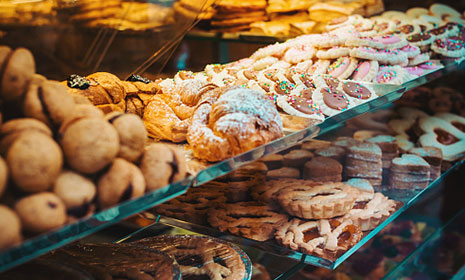
The Great British Bake Off returns to our screens this August and many of us will be on a knife edge waiting to find out who'll be crowned top baker in October. But not all of us have ambitions to become the next Mary Berry or Paul Hollywood, some of us just don't have the time – or inclination – to bake. That doesn't stop us from looking lovingly at all the cakes and bakes that are available in the shops, though.
Having diabetes doesn't mean you have to stop enjoying the occasional treat. But it does pay to know what's going into the treats you buy, and to think about how foods like this can fit into overall diabetes management.
Being aware of how to read food labels and portion sizes can help you stay in control.
6 top tips for buying baked goods
Top ways to buy a healthier bake and what to look out for in the bakery aisle.
Tip 1: read the labels
Most packaged foods now contain nutritional information on the front and back of the pack to help you make healthier choices.
Find out more aboutinterpreting labels on food packaging.
Tip 2: read the ingredients list
On the back of the packaging, you’ll find more detailed nutritional information including carbs. The ingredients list is also here and will tell you the quantities of what’s in the product. Look for where sugar appears on this list – the ingredients are listed with the largest amount first – to help you compare products. Other words for ‘free’ or ‘added’ sugar include honey, syrup, fructose and glucose.
Tip 3: what about food with no labels?
Many baked goods from the bakery section often aren't labelled, but a quick google search at home will give you this information.
At Enjoy Food, we carried out a little experiment. We looked online at the nutritional information for three unwrapped baked foods (a cookie, a scone and a muffin) from a well-known UK shop. We noted the average carbs, sugar, fat and calorie content. It revealed some interesting findings.

Cookie
45g carbs, 16.4g fat, 31.6g sugar, 415 calories

Scone:
39g carbs, 14.3g fat, 8.5g sugar, 314 calories

Muffin
59g carbs, 36.6g sugar, 21.7g fat, 460 calories
If we adopt the government’s colour code labelling system, to show if a food was low, medium or high in a particular nutrient then, with the exception of the scones, the cookie and muffin would be colour coded red (ie high) for fat and sugar. The scones would be coded amber, which is medium.
With the new daily maximum ‘free’ sugar (formerly ‘added’ sugar) target now being slashed by half to 30g of ‘free sugar’ a day and, given that most of the sugar in these products is ‘free’ (or ‘added’) sugar, you can see that by eating a cookie or muffin you would have exceeded your sugar target for the day without eating or drinking anything else.
Look at the calorie content as well as the carbs, sugar and fat. The calories in the cookie and muffin are as much, if not more, than some adult meals. Instead of the cookie or muffin you could have had a chicken salad sandwich, an apple and a satsuma, and still be eating less than 400 calories.
As we know, just 100 calories extra per day could see you put on about 11lbs (5kg) over a year. If you reverse this, by eating 100 calories less a day by making a better choice, you would lose 11lbs (5kg) a year.
Tip 4: watch out for foods with a 'healthy' image
Some people assume that products like flapjacks, cereal bars and wholemeal muffins are much healthier than they actually are. These products still contain high levels of sugar and fat – so check the labels before you buy. Don't be taken in by the hype.
Tip 5: avoid foods labelled 'diabetic'
You may come across foods labelled 'diabetic' – it's best to avoid these products as they are usually more expensive and don't offer any health benefits for people with diabetes. They may even have a nasty laxative effect.
Tip 6: be mindful of portion sizes
You’ve probably noticed that portion sizes of baked goods have increased considerably over the last decade. Scones, bagels, cookies and muffins can often be up to double the size they were.

- 1993 average muffin size was 85g with 280 Kcal
- 2015 average muffin size is 130g with 475 Kcal
This means more carbs, more fat, more sugar and more calories, which can affect your diabetes control, weight and health.
So, to help with portion-size control, try:
- Looking for smaller sizes of your favourite treats. Shops now sell mini muffins, treat-sized flapjacks and smaller cookies. Coffee shops have also started selling smaller pastries.
- Buying individually wrapped cake bars, malt loaf and mini rolls so you are not tempted to eat them all.
- Not going shopping when you’re hungry, but if you have to, avoid the bakery section of the stores if you know it will be too tempting.
- Only buy discounted cakes, cookies or other baked goods if you can freeze what you don’t need.
- Getting into the habit of cutting the portion sizes down yourself. Just because the shop sells cookies the size of a plate doesn’t mean you can’t reduce it down yourself.
- Freezing some for later. Make sure you wrap them in foil, label and put in freezer bags.
